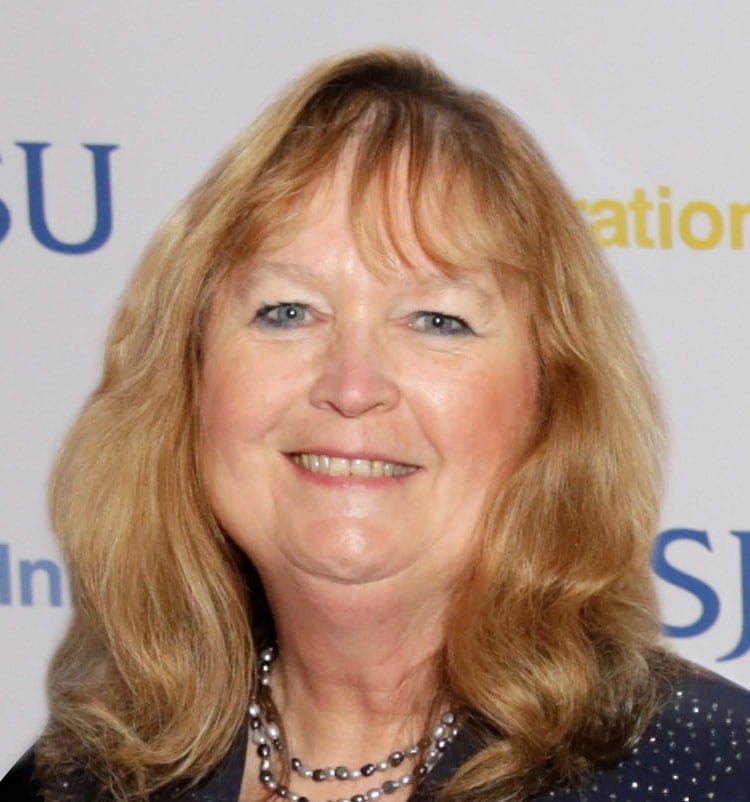
San Jose State Professor of Political Science Frannie Edwards will conduct a webinar on April 9, “Transit and COVID-19: How Its Impact Differs from Other Emergencies,” where she’ll discuss the similarities and differences between the impact of COVID-19 and other contagious diseases such as SARS and H1N1/swine flu on transit systems. Photo courtesy of Frannie Edwards.
San Jose State Professor of Political Science Frannie Edwards will conduct a webinar this Thursday, April 9, “Transit and COVID-19: How Its Impact Differs from Other Emergencies,” where she’ll discuss the similarities and differences between the impact of COVID-19 and other contagious diseases such as SARS and H1N1/swine flu on transit systems.
Edwards, who also teaches emergency management and serves as the deputy director of the National Transportation Security Center at the university’s Mineta Transportation Institute, served for 14 years as director of the Office of Emergency Services in San Jose and as director of the city’s Metropolitan Medical Task Force.
Edwards developed her expertise through an impressive array of academic work, research and classroom teaching.
“Teaching is my passion, and I really want my students to learn the things they’ll need to know in order to be successful and creative servants of their community,” she said. “But it’s the research and my own constant learning that fuel my ability to teach effectively and give students the tools they need.”
Edwards’s emergency management background draws on lessons learned while living in Japan, serving as a police budget officer for the City of Irvine and developing emergency plans for earthquakes, floods and other disasters.
Hired into her current role at SJSU in 2005 to teach public administration, Edwards was brought into MTI’s fold as a research associate to help with the Institute’s fast-growing anti-terrorism work. Transit organizations nationwide had been persuaded to take such threats seriously after the 1995 sarin gas attack on a subway system in Tokyo and other high-profile events.
Edwards and a small group of colleagues became MTI’s de facto emergency preparedness brain trust, giving presentations and briefings via a “traveling road show” of sorts around the state. She and her research partner Dan Goodrich are co-authors on more than a dozen MTI publications on emergency preparedness.
In a profession that uses a lot of acronyms, Edwards refers a great deal to one in particular—COOP. A COOP plan, or, “continuity of operations” effort, is a collection of resources, actions, procedures and information that is developed and used to maintain critical operations after a disaster or emergency. Edwards characterizes COOP as the “next level” of emergency management.
“An emergency operations plan outlines what you should do when something really bad happens, and it typically lays out all the resources at your disposal,” she explained. “A continuity of operations plan outlines what to do when there are no resources, but still a lot of people who need help.” An essential concept behind COOPs, she explained, is that organizations must identify those activities that are the most essential in order to execute the mission—while ceasing all other activities.
SJSU, she points out, essentially put a COOP into operation in the early stages of the Coronavirus pandemic when it hit the pause button on athletics activities, large events and public gatherings in general. Instead, university leadership asked itself, What do we need to do in order to keep educating our students, finish the semester and keep everyone on track to earn credits and graduate on time? That, Edwards explained, is COOP in a nutshell: narrowing one’s world to just the essentials.
Edwards said, in fact, that the current crisis is the only one she has seen in more than 30 years of emergency management that represents “a true COOP situation.” The geographic impact of other crises, such as the 1989 Loma Prieta earthquake, the Northridge (Los Angeles County) earthquake in 1994 and the 1998 El Niño floods in the Bay Area, have been relatively small compared to COVID-19. The shortage of available pumps during the floods were a precursor to today’s shortage of ventilators and other personal protective equipment, though at a much smaller scale.
Edwards remains optimistic during the current crisis and chooses to focus on the “inspiring things going on.”
Mobilizing two large naval hospital ships to assist overwhelmed hospitals amid the pandemic was a smart use of resources, she said, while the work of the nation’s medical community and caregivers has been nothing short of heroic. In addition, she points to the number of companies, including many in Silicon Valley, who have contributed large sums of money to the overall effort. “We are seeing a wonderful charitable spirit that is helping people in our communities who are struggling,” she said.
To help get through the crisis, Edwards emphasizes the need for people to find creative ways to stay connected and remain true to their own passions and needs, whether it is through a religious community they may be part of, online museums and music or even just regular calls or emails to friends.
“Whatever it is that feeds your soul, brings you happiness and hope and helps you see a brighter future—those are the things we all must continue to do.”
Those interested in the 4/9 webinar can register to receive an email reminder. The webinar takes place from 10-10:30am and will be conducted via Zoom.
